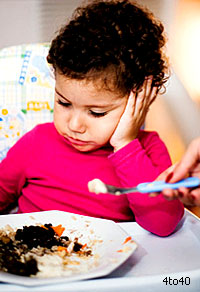 Come mealtime and a picture of an ensuing battle – getting your child to eat – invariably flashes past your eyes. All your efforts to make healthy food choices for your child meet with resistance, as there is no help from their end. This is a familiar story I am sure. Food negativism is a problem of defiance by the determined toddler against parental pressure. Here are some ideas for promoting healthy eating habits and combating food negativism in children.
Come mealtime and a picture of an ensuing battle – getting your child to eat – invariably flashes past your eyes. All your efforts to make healthy food choices for your child meet with resistance, as there is no help from their end. This is a familiar story I am sure. Food negativism is a problem of defiance by the determined toddler against parental pressure. Here are some ideas for promoting healthy eating habits and combating food negativism in children.
Let your child’s hunger mechanism get some practice: Do not force feed your child and don’t worry, as your child will rarely under eat. Young children know how to self select sufficient quantities of food. It may not seem so during all meal timings but eventually, they manage to compensate.
Get imaginative
Most children are experimental at this age. Try new flavours and textures. A highly colourful food will catch your child’s interest definitely, as will a mild aroma and a tasty appeal. Always remember children are reasonably good judges of the quality of food being served and taste always rules. For better acceptance get out of the rut of rotating the same three foods. Serve them variety.
Perseverance Pays
Go slow. Don’t ever force your child to eat new foods. Offer these one at a time, along with their favourite tried out fare. And do so over a period of time. If you don’t succeed at first, try again after a while. It takes the average toddler eight to 12 times of exposure to a food before he or she will consider eating it. Keep this in mind always and be patient.
Activity is the key
Low level of activity is quite often the devil in disguise responsible for food negativism in children. Which is why children who exercise regularly are more inclined to have a better appetite. So plan fun fitness activities for your child like walking the dog, jumping rope, going for a hike on weekends.
Avoid rigidity of food regime
Children feel different, inferior or unfairly singled out – so they get tempted to defy the regime and resist the dietary schedule. Also never use food as a reward or punishment. Promising an ice cream for drinking soup is not an effective long-term solution. It might just put the child off soup completely. Always use non-food rewards like a promise for an outing or buy the child a necessity.
Capitalise on the hungriest time
Introducing a vegetable just prior to dinner when the appetites are big, may just help you win over that vegetable hater child of yours. Keep some frozen healthy stuff ready for such times.
Involve children in all aspects of meal planning
Let them help in cooking and shopping. They are more likely to be cooperative in eating a food they have helped prepare. This is particularly true for healthy foods. Your child would be more willing to try out the vegetables he had helped pick you up from the supermarket.
Mealtime to be a happy occasion
The atmosphere at the dinner table is very important. When meal times are pleasant children enjoy the sociability and food becomes a part of this pleasant scene. Mealtimes should be fun and stress free. Avoid negative comments, bickering and arguments totally. Also when children eat with their parents and siblings, they often eat healthier foods, especially if they too are eating those foods.
Be a role model
Understand your role in shaping dietary patterns. Children note your patterns early in life. The urge to mimic is there and they begin to emulate your habits. Good nutrition for children begins with good nutrition for the parents. Start early to create a lifetime of healthful eating habits for your child.
 Kids Portal For Parents India Kids Network
Kids Portal For Parents India Kids Network






